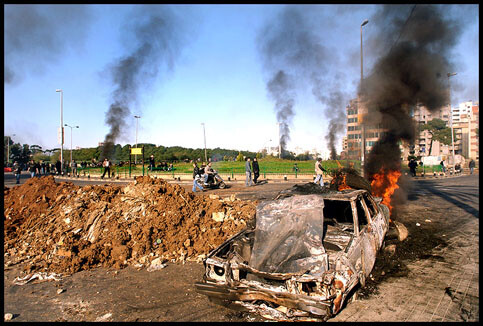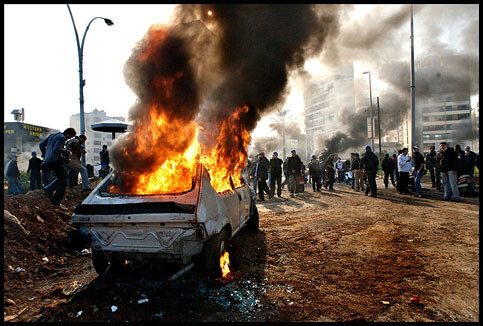Beirut 24 January 2007

Fires in Beirut during the Lebanese opposition general strike, January 23rd, 2007 (Photo: Paul)
It has been an insane twenty-four hours in Lebanon. It began when a photojournalist friend called to invite me out to accompany him on his shoot. The first stop was the tent city sit-in downtown. I’ve been there many times, but he was going around with Aoun and Hezbollah officials so I was excited to have an opportunity to speak with them while my friend shot his pictures for a European newspaper. It’s so interesting periodically walking around this space. Each time I go there I see new elements of a mini village set up. One tent in the Aoun area has potted flowers and tents all around it and last night I met the woman who stays in that tent. There’s also a commercial area of sorts that includes a saj sandwich tent, an espresso tent, snack and water tent among other things. We arrived down there right as Hassan Nasrallah gave his Ashoura speech in Al Dahiya, something that was somewhat of a surprise. My friend had been trying to take shots in Al Dahiya all day but security was tight and this was obviously why. We watched the end of the speech in one of the tents (yes, there is electricity down there and it’s actually quite a bone of contention because it’s on the tax payer’s dime).
That was my friend’s first story. The second one was not on the political situation here, but rather on the never-ending fascination with contrasting, complex representations of Lebanese women. Not really a favorite subject of mine when it’s presented in western media outlets. It’s like Katherine Zoepf’s “Beirut Journal: Where the Boys Are, at Least for Now, the Girls Pounce,” which appeared in the New York Times back in November. That article focused on the hyper-sexualized club scene here as well as a supposed heterosexual male shortage in Lebanon. The article was completely acontextual and would be the equivalent of writing a story about sexuality in the U.S. that made it seem like Sex and the City is a norm for all women across the country. The story my friend was working on was a bit different in that the photo editor requested shots of things that just don’t exist in Lebanon such as nightclubs filled with women in hijab, exposing their breasts, and dancing on table tops or some such thing. It’s like the Mark Twain version of Beirut that never seems to die (Twain famously stated in The Innocents Abroad that women in Beirut cover their heads but bear their breasts). It was insane because the newspaper also wanted shots of downtown 2006 war ruins being rebuilt—another thing that doesn’t exist. Apparently such requests come from parachute journalists. These people don’t live in a particular region, but just fly in to do a story without knowing or understanding the context and often have a particular idea of how they want to frame the story before they even arrive. Hence, making requests of photojournalists who live in the country and as a result have a better understanding of the cultural and political context. We headed over to a nightclub in Ashrafiyeh, which was packed even though it was a Monday night. It turned out to be part karaoke bar and part nightclub. It was especially odd to see everyone partying knowing what would be going down the following day. We were there until 3 AM and the party was still going on. Certainly the episode, sandwiched between the camp downtown and today’s events, highlights the complex, contradictory nature of Lebanese society. It just doesn’t always appear in some neat little package and there are often walls or streets separating these elements.
Before going out last night I stocked up on food and water like everyone else it seemed, and it was a really good idea. When I woke up and walked around my neighborhood of Ras Beirut and Hamra, there were no sounds. Normally my apartment here is noisier than when I lived on the corner of 62nd and Lexington in Manhattan. But today there were no sounds: no cars driving, no horns honking, no children playing, no construction work. Nothing. It reminded me of Amman on Friday mornings. Of course Hamra, like all the other neighborhoods in and around Beirut, was a ghost town because of the general strike called for today by opposition forces. But unlike a strike, which gives individuals a choice about whether or not they want to go to work this work stoppage was enforced in a variety of ways from both the government and opposition forces. While Nasrallah and Michel Aoun called for people to stay at home, MP Samir Gaegea stated, in a Bushism manner, “the conflict in Lebanon ‘is between those who want a Lebanon ruled by [Iran’s supreme leader, Ayatollah Ali] Khamenei and those who want a Lebanon of Pope John Paul II’” (). In other words, you’re with us or you’re against us.

Fires in Beirut during the Lebanese opposition general strike, January 23rd, 2007 (Photo: Paul)
The strike became, as one AUB colleague put it, like National Coming Out Day on U.S. university campuses. On this day students are told if you wear blue jeans you’re identified with supporting queer rights. Thus, on one October day every year you see college kids changing from their usual attire to khakis or some other generic uniform. Today, one’s politics were likely identified by whether or not they showed up to work. Or at least this would be true in theory. There are many people who wanted to go to work who were just not able to. One of my students spent five hours trying to get home last night, but was unable to do so and had to sleep at a friend’s house. AUB is going to offer make-up final exams for those who had them scheduled today because so many students didn’t or couldn’t show up.
Although it felt relatively quiet in my neighborhood that was only true at its center. All along the periphery there were burning tires. In fact, just outside Ras Beirut in Rouche just outside of Future TV’s headquarters was one of the worst sites of conflict. There was a stone throwing fight and at least two people were injured there. All around the streets of Beirut there were young men—many teenagers, but some younger boys as well, with sticks trying to keep cars from passing. In some places where things got particularly violent, car tires were slashed and car windshields were broken. Opposition forces also towed broken-down, dilapidated cars and vans to various traffic circles around the city, on top of piles of dirt, and lit the cars on fire. They also brought in tires on trucks, which drove right past the Lebanese military tanks, and young boys would pile them on the streets and light them on fire.
Much of the violence, while falling down party lines, played out, at least rhetorically, in terms of pro-Syria and anti-Syria arguments. The stone throwing seemed to fall along those lines with the Lebanese security (police and army) trying to intervene and protect both sides. At times they fired shots in the air to break up these particularly tense interactions. By early afternoon most of the demonstration was over and crowds had dispersed. What remained were groups of ten to thirteen-year-old boys walking in groups of ten to fifteen people with sticks, tipping over garbage cans and intimidating people. These worst elements of the day’s events seemed more like a riot and less like a general strike. Rather than allow people to make choices about whether or not they participated in the strike, the country was cut in half and people were prohibited from driving to or from home or work.
While things seem relatively calm once again, there are calls for escalating yesterday’s events from Aoun. But for now Prime Minister Siniora seems to be on his way to the Paris III donor conference. All that remains now are the rumors of retaliation for yesterday’s violence. It is feared that the 3-5 deaths and 133 injuries may elicit reprisals.
Dr. Marcy Newman is Visiting Professor at the Center for American Studies and Research at the American University of Beirut. She works with Civilian Resistance in Lebanon. You can follow her activities at her blog Body on the Line.
Related Links





